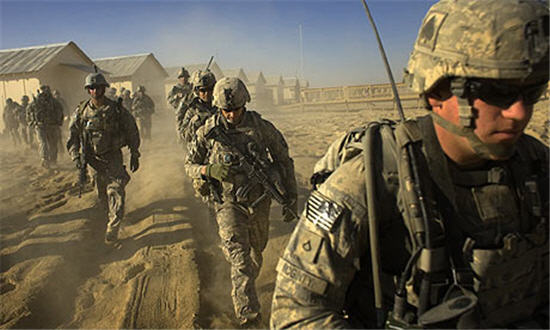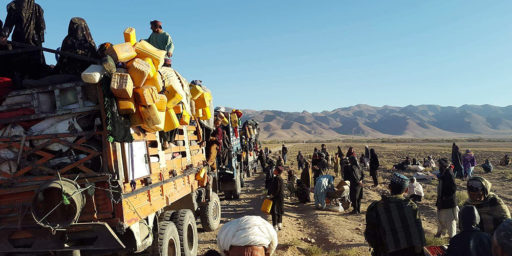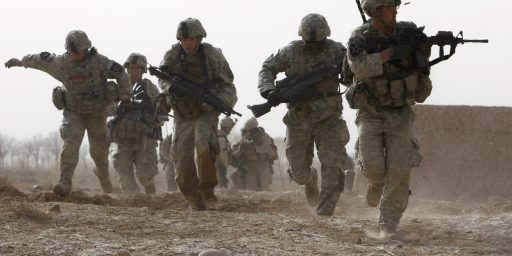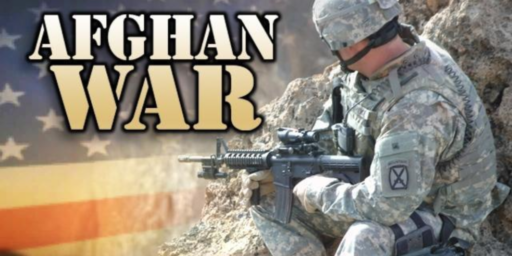U.S. To Halt Withdrawal Of Forces From Afghanistan
The plan to withdraw nearly all American forces from Afghanistan by the end of 2016 is being put on hold.
Later today, President Obama will announce that the ongoing withdrawal of American troops, which would keep nothing put a small token force in the area around the U.S. Embassy by the end of 2016, will be halted and that the troops currently in country will stay there at least until after he leaves office:
WASHINGTON — The United States will halt its military withdrawal from Afghanistan and instead keep thousands of troops in the country through the end of President Obama’s term in 2017, Mr. Obama will announce on Thursday, prolonging the American role in a war that has now stretched on for 14 years.
The current American force in Afghanistan of 9,800 troops will remain in place through most of 2016 under the Obama administration’s revised plans, before dropping to about 5,500 at the end of next year or in early 2017, senior administration officials said.
Some of the troops will continue to train and advise Afghan forces, while others will carry on the search for Qaeda fighters and militants from the Islamic State and other groups who have found a haven in Afghanistan, they said.
In abandoning his ambition to bring home almost all American troops before leaving office, Mr. Obama appears to be acknowledging that Afghan security forces are still not near ready to hold off the Taliban on their own.
The insurgents are now spread through more parts of the country than at any point since 2001, according to the United Nations, and last month the Taliban scored their biggest victory of the war, seizing the northern city of Kunduz and holding it for more than two weeks before pulling back on Tuesday.
Yet even before Kunduz fell to the Taliban, the administration had been under growing pressure from the military and others in Washington, including Congress, to abandon plans that would have cut by about half the number of troops in Afghanistan next year, and then drop the American force to about 1,000 troops based only at the embassy in Kabul by the start of 2017.
Now, instead of falling back to the embassy — a heavily fortified compound in the center of Kabul — the administration officials said on Wednesday that the military would be able to maintain its operations at Bagram Air Field to the north of Kabul, the main American hub in Afghanistan, and at bases outside Kandahar in the country’s south and Jalalabad in the east.
All three bases are crucial for counterterrorism operations and for flying drones that are used by the military and the C.I.A., which had also argued for keeping troops in Afghanistan to help protect its own assets.
There was no set date for the military to decrease the number of troops in Afghanistan to 5,500, said the administration officials, who spoke on the condition of anonymity because they did not want to pre-empt Mr. Obama’s announcement. The pace of that troop reduction would be determined largely by commanders on the ground, and the timing would also most likely provide flexibility to whoever succeeds Mr. Obama.
President Ashraf Ghani of Afghanistan had also pressed for Mr. Obama to keep more troops, and many in Washington who have worked closely with the Afghans over the past several years were loath for the United States to pull back just when it had an Afghan leader who has proved to be a willing partner, unlike his predecessor, Hamid Karzai.
Mr. Ghani is acutely aware of his country’s need for help from the United States and its NATO allies. The American military has repeatedly stepped in this year to aid Afghan forces battling the Taliban, launching airstrikes and at times sending Special Operations troops to join the fight, despite Mr. Obama’s declaration that the American war in Afghanistan had ended.
More from The Wall Street Journal:
WASHINGTON—President Barack Obama will say Thursday that he has ordered a significant slowdown in the withdrawal of American troops from Afghanistan, senior administration officials said, a decision that marks a major reversal in his war plan and effectively hands the conflict over to his successor.
Under pressure at home and abroad, Mr. Obama decided—following a strategy review—to maintain the current American force of 9,800 troops in Afghanistan through most of next year, and to leave a force of 5,500 U.S. troops in the country in 2017, when he leaves office, the senior administration officials said.
The announcement will mark a dramatic shift in strategy by scrapping Mr. Obama’s previous plan, in place since last year, to steadily withdraw the 9,800 U.S. troops through 2016 and to leave only about 1,000 at the U.S. embassy by the time he leaves office.
But a spike in insurgent violence and uneven performance by Afghan forces led top U.S. commanders to openly question the president’s strategy and brought exhortations from U.S. allies to change course. This left Mr. Obama little choice but to scuttle his plan to wind down U.S. involvement, marking another setback for his efforts to untangle the U.S. from more than a decade of war.
In a further strategy change, the 5,500 remaining troops will be stationed at points far beyond the Afghan capital of Kabul, officials said, serving in Jalalabad in the east, Kandahar in the south, and at Bagram Air Field.
The shift follows a sharp rise in violence, including an assault by Taliban militants whotemporarily seized control last month of the northern city of Kunduz. The policy reversal also comes amid growing concerns that a drawdown of U.S. forces in the country could create an opening for Islamic State militants who have gained control of large parts of Iraq and Syria.
One senior administration official previewing Mr. Obama’s announcement at the White House said the president’s decision is the result of “an extensive and months long review” that included consultations with his top advisers, including U.S. military commanders, as well as with the Afghan government.
Officials said there is no time frame for the drawdown of U.S. forces in 2016 to 5,500 from 9,800. Mr. Obama will determine the timing next year based on discussions with commanders, they said, leaving open the possibility of retaining the current level of American forces in Afghanistan beyond next year.
Officials said the U.S. mission will be the same—counterterrorism operations and training and assisting Afghan forces.
Among factors Mr. Obama weighed in mit waaking his decision were the risks to U.S. troops and the overall mission, as well as the costs of keeping a more robust force in Afghanistan, officials said.
The cost estimate for the new plan is about $14.6 billion annually, an increase from the 2014 plan which costs about $10 billion a year, officials said.
Another senior administration official pointed to indications from some North Atlantic Treaty Organization allies that they want to maintain their presence in Afghanistan.
At a NATO meeting in Brussels last week, nearly all U.S. allies signaled a preference for a higher troop presence, U.S. officials attending the session said. Administration officials said talks with NATO allies on troop levels would continue.
Afghanistan President Ashraf Ghani was among those calling for a larger U.S. and NATO troop presence. “The Afghan government is very comfortable with this commitment,” a senior administration official said of the new arrangement.
Mr. Obama’s review of varying options for troop levels in Afghanistan was undertaken amid pressure from some lawmakers in Congress and from his own military commanders to keep a larger U.S. troop presence in the country compared with what was outlined in his current drawdown plan.
Today’s announcement does not come as much of a surprise, of course. Last week, it was reported that Obama was considering a plan similar to what is being announced today based on recommendations from General Martin Dempsey before he stepped down as Chairman of the Joint Chiefs of Staff. The recommendations were made in the wake of news that the security condition on the ground had deteriorated in the wake of reports that the Taliban had been scoring significant gains against Afghan security forces in recent months, capped most significantly by the capture of Kunduz by a small group of Taliban forces who were able to defeat a much larger, and supposedly better equipped and trained Afghan force. The signs that the initial commitment to have nearly all American troops out by the end of 2016 wouldn’t last were there long before this summer, though. Last November, not long after the President made the initial announcement about the new American strategy, it was announced that the pace of withdrawal would be slowed and that American troops would continue to be involved in combat operations. When Afghan President Asraf Ghani visited the United States amid reports of increased Taliban activity, it was announced that the pace of withdrawal would be slowed even further. Finally, in April we learned that American forces were involved in more than just the counterterrorism operations that President Obama’s original plan had said they would be limited to. Taking all this together, and taking into account the reports about the situation on the ground in Afghanistan, which has been largely ignored by the American media until the reports earlier this month about American bombs hitting a Doctors Without Borders hospital in Kunduz, it was fairly easy to see this announcement coming.
If nothing else, this announcement after months of the President emphasizing, quite often in speeches at military facilities or before military groups, that nearly all American troops would be withdrawn from Afghanistan by the end of 2016 is a stark indication that America’s longest war isn’t coming to an end any time soon. As we’ve already seen, the situation on the ground in Afghanistan since the United States turned over most of the responsibility for the fight against the Taliban to the Afghans has deteriorated significantly, with the Taliban making serious gains that had been denied to them in the past. To some degree, this is likely a reflection of the fact that the Afghans simply aren’t as skilled as American forces, of course, but it’s also likely that the Taliban had spent the last several years scaling back operations waiting for the inevitable point at which the Americans would begin scaling back their operations. In response to that rise, we’ve seen American forces increase their involvement on behalf of Afghan forces, and while it is unlikely to reach the levels it was at the height of the war, it seems clear that the troops that will now be left behind aren’t really going to be limited to the counterterrorism operations that the White House intended for them.
The real question, of course, is what this announcement and the decision to keep an American force in Afghanistan longer than expected will actually accomplish. In the short term, perhaps, it will slow the Taliban down a bit and give the Afghans more time to train their forces to fight them, but that training has been going on for some time now and if the Afghan Army isn’t ready to defend the country on its own now it’s not clear when they will be ready. Additionally, the presence of this kind of contingent of American troops is likely to present a tempting target for the Taliban themselves, as well as for the ISIS-related forces that seem to be infiltrating the country in recent months. One attack on an American base is likely to lead to calls for escalation that the President may find hard to resist, especially given our involvement in the fight against ISIS in Iraq and Syria. In the end, there doesn’t seem to be any good solution to this situation. It’s undeniable the that Afghans are having trouble fighting the Taliban on their own, and the injection of ISIS into the equation could make things worse in the long run, but at some point they need to defend themselves rather than relying on the United States and NATO to do it for them. We’ve been fighting in Afghanistan now for fourteen years, though, and there doesn’t seem to be any sight of it coming to an end any time soon.






The thing we can’t seem to figure out is that Afghanistan is a tribal society and that many or most of them have no real sense of country, often don’t even speak the same language and often don’t like each other. This is the pool you have to try to create and Afghan military. This is pretty much a hopeless situation,
For all of the chest-beating about how democracies have their hands tied in places like Afghanistan, the Russians fared exactly as we have, and they had no press and no regard for the Geneva Conventions. There’s no reason why we should be staying. There’s no magical solution that will allow America to exit with a stable government tolerable to American interests left behind.
I’m curious about how much of a financial investment the military has made in Pakistan/Afghanistan area. Maybe the 5,000 troops are pieces in a game designed to keep special ops in the area. How much do the officers who leave to go to work for some private firm stand to lose if there’s withdrawal?
From Obama’s speech:
“I know many of you are wary of this conflict,” said Obama. “I don’t support the idea of endless war, but given what’s at stake and the fact that we have an international coalition, I am firmly convinced we should make this extra commitment.”
Not endless war, surely not, but simply not having the inevitable occur under his watch.
This is nothing but kicking the can down the road. There was never any hope of stabilizing Afghanistan for the reason I mentioned above @Ron Beasley: 5,500 troops is going to accomplish nothing.
This is nothing but kicking the can down the road. There was never any hope of stabilizing Afghanistan for the reason I mentioned above @Ron Beasley: 5,500 troops is going to accomplish nothing.
condom after sex…..heck. i didn’t vote for him so wtf cares anymore?
I just like to say that this article is awesome, nice written and brings along all important information needed.